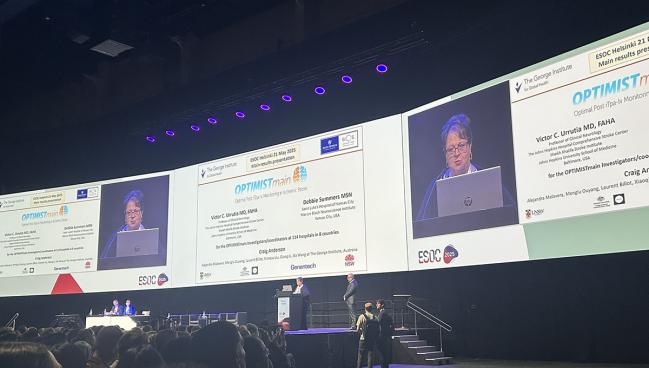Less Intense Checks May Be OK After IV Thrombolysis for Stroke: OPTIMISTmain
Pulling back on the level of monitoring could improve nursing workflows and reduce resource use.

HELSINKI, Finland—It may be possible to safely cut back on the level of monitoring performed in select patients with acute ischemic stroke treated with IV thrombolysis, results of the OPTIMISTmain trial suggest.
The proportion of patients with a poor functional outcome at 90 days was 31.7% among those managed with low-intensity monitoring and 30.9% among those who received standard monitoring, a difference that fell just shy of establishing the noninferiority of the less-intensive approach (P = 0.057).
There were few cases of symptomatic intracerebral hemorrhage in either group—five and eight with low-intensity and standard monitoring, respectively.
Debbie Summers, MSN (Saint Luke’s Hospital of Kansas City, Marion Bloch Neuroscience Institute, Kansas City, MO), and Victor Urrutia, MD (Johns Hopkins University School of Medicine, Baltimore, MD), reported the results recently at the European Stroke Organisation Conference (ESOC) 2025. They were published simultaneously online in the Lancet.
Despite the borderline significant noninferiority result, “we believe that the data show clinically robust evidence that low-intensity monitoring in stroke patients with mild-to-moderate-severity strokes treated with IV thrombolysis is safe, well accepted by patients, nurses, and clinicians, and likely to provide cost savings driven by lower ICU bed use,” Urrutia said during his presentation. “Hospitals should consider incorporating this approach according to local circumstances and resources.”
Teresa Ullberg, MD, PhD (Lund University, Sweden), who was not involved in the study, pointed out that there is a shortage of nurses in many parts of the world.
Everything that is demanding less resources from our personnel at the stroke units and the ICUs is a good thing if it doesn’t compromise patient safety and the effects of the treatment we give our patients,” she told TCTMD.
And even though OPTIMISTmain did not reach its noninferiority goal, “I think from the data we can say that it is not unacceptably worse, even though it was just borderline significant,” Ullberg added.
The OPTIMISTmain Trial
Recommendations for monitoring after the use of IV thrombolysis are based on the original alteplase trials conducted in the 1990s, said Summers. “With passage of time, we recognize that current practice requires intensive nursing care and patients cared for in the ICU, which increases cost,” she said. “We also know that it is disruptive to [sleep patterns] and it may impair recovery.”
At Johns Hopkins, Urrutia and one of his colleagues developed a less-intensive monitoring protocol, which was compared to the standard approach in OPTIMISTmain, a stepped-wedge, cluster-randomized trial conducted in 114 hospitals in eight countries. The study included 4,922 patients (mean age 66 years; 38% women) who had an acute ischemic stroke who were treated with IV thrombolysis, had mild-to-moderate deficits (NIHSS score < 10) within 2 hours of the end of the infusion, and were clinically stable. Median NIHSS score after IV thrombolysis was 3.
Hospitals were randomized to three different progressions from standard to low-intensity monitoring. The low-intensity protocol called for assessments of neurological and vital signs every 15 minutes for the first 2 hours, followed by checks every 2 hours for the next 8 hours (compared with every 30 minutes for 6 hours with standard monitoring). After that, patients in the low-intensity group were assessed every 4 hours, and those in the standard group every 1 hour, up to 24 hours after treatment.
As designed, the low-intensity protocol reduced the median number of neurological and vital sign assessments compared with standard monitoring (17 vs 37), with a lower rate of ICU use in the first 24 hours (13% vs 17%). The difference in ICU use persisted through 7 days or hospital discharge (15% vs 21%).
The primary outcome was the proportion of patients with a poor functional outcome, defined as a modified Rankin Scale (mRS) score of 2 to 6, at 90 days. The minimal difference between trial arms remained consistent across various subgroups. Additionally, there was no significant difference in the overall distribution of mRS scores (common odds ratio 1.03; 95% CI 0.89-1.20) and no major impact on secondary outcomes.
Safety was similar in the two groups, with a serious adverse event rate of 11.1% in the low-intensity arm and 11.3% in the standard arm.
“Our process evaluation showed that the less-intense monitoring was perceived as easy to implement, valuable, and good for patient care,” Urrutia said. He added that it allowed for more “free time for nurses to engage in other aspects of patient care, such as mobility, recovery, [and] patient and family education.”
My impression is that patients perceive this intervention positively, and both the doctors and the nurses felt that resources were used more sensibly than before. Teresa Ullberg
The low-intensity protocol would be appropriate for the types of patients included in the trial, Ullberg indicated, pointing to patients with mild-to-moderate strokes and a low risk of serious adverse events.
As for whether the results will change practice more broadly, she noted that there is typically a long period between initial trial results and implementation in daily routines.
“I don’t know how long it could take before this intervention will be translated into routine healthcare, but we can certainly learn something from this strategy,” Ullberg said. “My impression is that patients perceive this intervention positively, and both the doctors and the nurses felt that resources were used more sensibly than before.”
Todd Neale is the Associate News Editor for TCTMD and a Senior Medical Journalist. He got his start in journalism at …
Read Full BioSources
Anderson CS, Summers D, Ouyang M, et al. Safety and efficacy of low-intensity versus standard monitoring following intravenous thrombolytic treatment in patients with acute ischaemic stroke (OPTIMISTmain): an international, pragmatic, stepped-wedge, cluster-randomised, controlled non-inferiority trial. Lancet. 2025;Epub ahead of print.
Disclosures
- The study was funded by the National Health and Medical Research Council of Australia, a New South Wales Health Investigator Development Grant, the University of New South Wales Medicine Non Communicable Diseases Theme Early-Mid Career Research Seed Grant Scheme, the Medical Research Future Fund (for conduct in Australia), and Genentech (for conduct in the US).
- Urrutia reports having received grants from Genentech paid to his institution.
- Summers reports no relevant conflicts of interest.





Comments